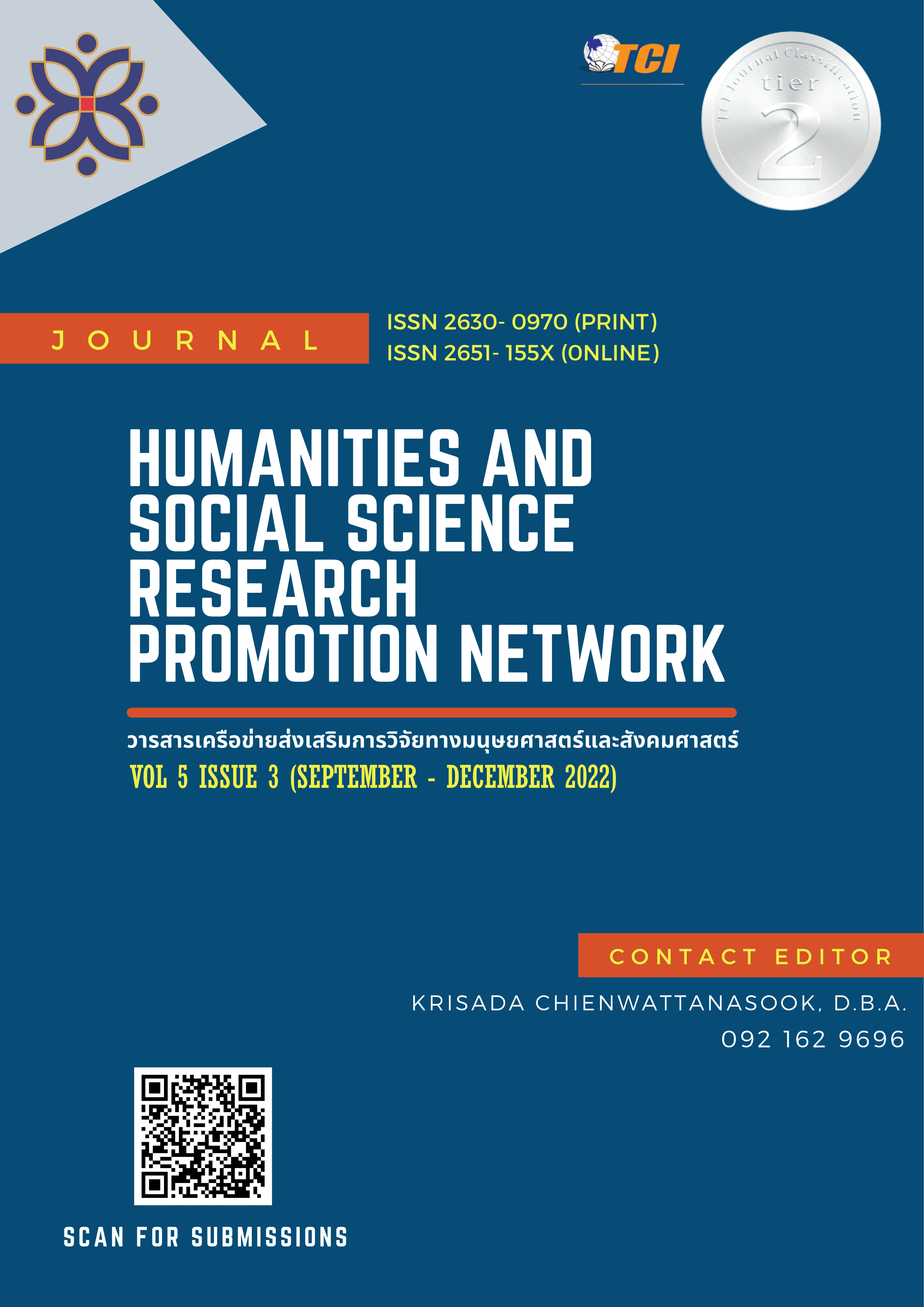แนวทางการพัฒนาแรงงานช่างฝีมือของอุตสาหกรรมเครื่องประดับไทย
คำสำคัญ:
แรงงานงานฝีมือ , การพัฒนา , อุตสาหกรรมเครื่องประดับบทคัดย่อ
งานวิจัยนี้มีวัตถุประสงค์เพื่อศึกษาลักษณะองค์กรที่มีอิทธิพลต่อการพัฒนาฝีมือแรงงานในอุตสาหกรรมเครื่องประดับไทย การจัดการความรู้มีอิทธิพลต่อผลการพัฒนาฝีมือแรงงานในอุตสาหกรรมเครื่องประดับไทย ปัจจัยการพัฒนาฝีมือแรงงานมีอิทธิพลต่อผลการพัฒนา และแนวทางการพัฒนาฝีมือแรงงานในอุตสาหกรรมเครื่องประดับไทย กลุ่มตัวอย่าง คือ ผู้ผลิตเครื่องประดับที่จดทะเบียนบริษัทและมีการใช้เพชร พลอย มุก และทองเป็นวัตถุดิบ จำนวน 297 คน สำหรับการวิจัยเชิงปริมาณนี้ ผู้วิจัยใช้แบบสอบถามในการเก็บข้อมูล และสำหรับการวิจัยเชิงคุณภาพ ผู้วิจัยสัมภาษณ์ผู้เชี่ยวชาญจำนวน 17 คน ในอุตสาหกรรมเครื่องประดับไทยโดยใช้การสัมภาษณ์เชิงคุณภาพในรูปแบบกึ่งโครงสร้าง สำหรับการวิเคราะห์ข้อมูลเชิงปริมาณนั้น ผู้วิจัยใช้ค่าร้อยละ ค่าเฉลี่ย ส่วนเบี่ยงเบนมาตรฐาน การวิเคราะห์ความแปรปรวนแบบทางเดียว และสถิติการถดถอยพหุคูณ สำหรับการวิเคราะห์ข้อมูลเชิงคุณภาพนั้น ผู้วิจัยใช้วิเคราะห์วิเคราะห์เชิงเนื้อหา ผลการศึกษา พบว่า การจัดการความรู้ด้านการระบุความรู้และการถ่ายทอดความรู้มีอิทธิพลต่อผลการพัฒนาฝีมือแรงงานที่ระดับ .05 นอกจากนี้ยังพบว่ามีกลยุทธ์ที่แตกต่างกันจำนวน 8 ประการที่สามารถใช้ในการส่งเสริมการพัฒนาช่างฝีมือของอุตสาหกรรมเครื่องประดับไทย ซึ่งหน่วยงานภาครัฐและผู้ประกอบการสามารถใช้ประโยชน์จากผลการศึกษาในครั้งนี้
เอกสารอ้างอิง
Ahmed, T., Khan, M. S., Thitivesa, D., Siraphatthada, Y., & Phumdara, T. (2020). Impact of employees engagement and knowledge sharing on organizational performance: Study of HR challenges in COVID-19 pandemic. Human Systems Management, 39(4), 589-601.
Argote, L., & Ingram, P. (2000). Knowledge transfer: A basis for competitive advantage in firms. Organizational Behavior and Human Decision Processes, 82(1), 150-169.
Bai, J., & Liu, J. (2018). A study on the influence of career growth on work engagement among new generation employees. Open Journal of Business and Management, 6(02), 300.
Center for Gem and Jewelry Information. (2020). The 2019 import and export status of Thai gems and jewelry. Bangkok: Thailand Gem and Jewelry Institute (Public Organization).
Chuangtrakul, J. (2010). The theory and practice of human resource management. Bangkok: SE-ED.
Deming, W. E. (2558, March 27). PDCA central to continuous improvement. Retrieved from National Productivity Institute. https://www.ftpi.or.th/2015/2125
Dong, Y., Bartol, K. M., Zhang, Z. X., & Li, C. (2017). Enhancing employee creativity via individual skill development and team knowledge sharing: Influences of dual‐focused transformational leadership. Journal of Organizational Behavior, 38(3), 439-458.
Duan, W., & Sheng, J. (2018). How can environmental knowledge transfer into pro-environmental behavior among Chinese individuals? Environmental pollution perception matters. Journal of Public Health, 26(3), 289-300.
Industrial Works Department Ministry of Industry. (2018). Number of gem and jewelry industry factories (cumulative) January through March of 2018 Institute of Textile Industry Development, Industrial Information and Digital Center, Bangkok. Thai Textile Information: https://thaitextile.org/th/insign/detail.253.1.0.html #
John W. Best & James V. Kahn. (1998). Research In Education. A Viacom Company: United State of America.
King, W. R. (2011). Knowledge sharing. In Encyclopedia of Knowledge Management, Second Edition (pp. 914-923). IGI Global.
Krejcie, R. V., & Morgan, D. W. (1970). Determining Sample Size for Research Activities. In Educational and Psychological Measurement, 607-610.
Kroon, J., De Klerk, S., & Dippenaar, A. (2003). Developing the next generation of potential entrepreneurs: co-operation between schools and businesses?. South African Journal of Education, 23(4), 319-322.
Nonaka I. (2007). The Knowledge Creating Company. Howard Business Review, 85, 162-171.
Onputtha, S., Sriboonlue, U., & Sriboonlue, O. (2021). The Role of Knowledge Transfer among Creative Behavior, Green Service Behavior and Environmental Performance in Logistics Service Industry. Journal of Management Information and Decision Sciences, 24, 1-12.
Ritthirong, C. (2015). Difficulties in Thailand's ability to produce qualified workers for the ASEAN Economic Community labor market. Diversity of Population and Society in Thailand, 129-147.
Stanovcic, T., Pekovic, S., & Bouziri, A. (2015). The effect of knowledge management on environmental innovation: The empirical evidence from France. Baltic Journal of Management, 10(4), 413-431.
Succi, C. (2015). Soft skills for the next generation: Toward a comparison between employers and graduate students' perceptions. Milano: Franco Angeli.
Sukortpromme, S., Onputtha, S., & Jotikasthira, C. (2019). The Effect of Employee’s Knowledge Learning, Knowledge Sharing and Working Skill on Employee Value in Anonymous Tire Manufacturing Company. International Journal of Applied Computer Technology and Information Systems, 9(1), 29-37.
Syed‐Ikhsan, S. O. S., & Rowland, F. (2004). Knowledge management in a public organization: a study on the relationship between organizational elements and the performance of knowledge transfer. Journal of Knowledge Management, 8(2), 95-111.
Thai Trade Statistics Division, Commerce Ministry (2019). Summary of export value statistics for Thailand Bangkok: Information and Communication Technology Center Office of the Minister of Commerce's Permanent Secretary.
Zack, M., McKeen, J., & Singh, S. (2009). Knowledge management and organizational performance: an exploratory analysis. Journal of Knowledge Management, 13(6), 392-409.
ดาวน์โหลด
เผยแพร่แล้ว
รูปแบบการอ้างอิง
ฉบับ
ประเภทบทความ
สัญญาอนุญาต
ลิขสิทธิ์ (c) 2022 ภูษิต ภูปภัสศิริ, เกียรติชัย วีระญาณนนท์, ชัยวุฒิ จันมา

อนุญาตภายใต้เงื่อนไข Creative Commons Attribution-NonCommercial-NoDerivatives 4.0 International License.
บทความที่ได้รับการตีพิมพ์เป็นลิขสิทธิ์ของ ผู้เขียน
ทัศนะและความคิดเห็นที่ปรากฏในบทความในวารสารเครือข่ายส่งเสริมการวิจัยทางมนุษยศาสตร์และสังคมศาสตร์จะถือเป็นความรับผิดชอบของผู้เขียนบทความนั้น และไม่ถือเป็นทัศนะและความรับผิดชอบของกองบรรณาธิการ








